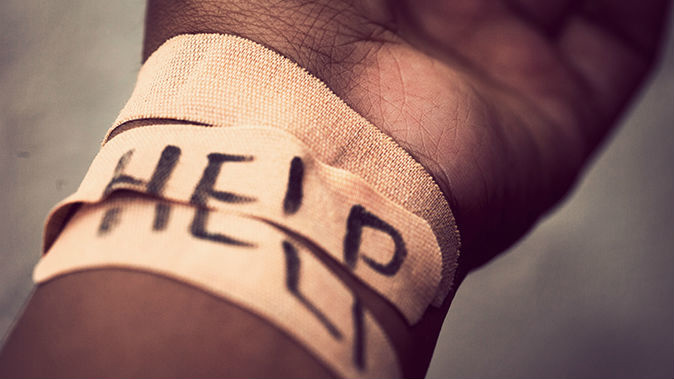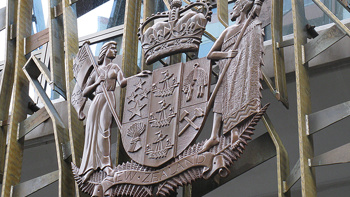
Warning: This article is about suicide and may be distressing for some readers.
• Almost half of our teenagers will self-harm before they leave high school.
• Thousands of young people are treated in hospitals for self-injuries every year - and the number is rising fast.
• New Zealand's hidden epidemic of self-harm has been described by one principal as "the elephant in the room in secondary schools".
• Our leading expert on self-harm is urging the Government to start an informed national discussion on the issue.
She'd wrap the blades in toilet paper and stash them in her pencil case.
She usually cut herself in the bathroom at school, leaning against the door of a toilet stall.
A thin red line, deep, shaky breaths and a blood-stained tissue.
Then she'd wrap her arm in toilet paper - round and round like a bandage - pull the sleeve of her school jersey down into her fist and walk back to class.
"It's pretty gruesome-sounding, but it didn't feel it at the time," says Victoria, now 23.
"You don't see it as mutilating your body; your brain somehow misses the more horrific aspect of what you're doing to yourself."
Ironically, Victoria would cut to take her pain away. The immediate burn was a relief from the emotional turmoil going on inside her head.
The New Zealand Herald's Break the Silence series this week investigates our hidden epidemic of self-harm. Not all those who self-harm want to die, but it can be a red flag for suicidal ideation and the most severe cases can be fatal.
Parents, principals and experts from across the country say that, like suicide, it's a self-destructive issue affecting thousands of young people every day - and we don't talk about it.
Many want to confront this, if only because of the sheer number of our kids harming themselves.
Recent research found that almost half of New Zealand teenagers will self-harm at least once before they leave school.
"Self-harming by cutting is the elephant in the room in secondary schools," says Ross Sinclair, former chairman of the Greater Wellington Secondary Schools Principals Association.
More than 11 New Zealanders under 25 are discharged from hospital with intentional self-harm injuries every day, according to data released to the Herald under the Official Information Act.
This figure does not include the thousands of teens treated by school nurses, family doctors, community health centres or hospital emergency departments after self-harming.
In the 2015/16 financial year, Canterbury District Health Board's emergency department saw 511 under 25-year-olds for "self-injury requiring medical attention", according to additional figures obtained under the OIA - about 10 a week in that region alone.
New Zealand's leading self-harm expert, Professor Marc Wilson, who has been studying the subject for more than a decade, says self-harm among teens has become increasingly more overt around the world in the past 15 to 20 years.

Professor Marc Wilson, New Zealand's leading expert on self-harm in youth is calling for an informed discussion in schools on this issue. (Photo / Mark Mitchell)
He says our official policies haven't kept up with the scale of the problem and schools have wildly different approaches when it comes to treating self-harming students.
Some send the students to hospital for urgent treatment and suspend them for a week, while others send students to the school nurse for a sticky plaster and tell them to "quickly get back to class", the Herald's investigation found.
"There is a huge variability and a lot of inconsistency. You can't guarantee two schools in the same suburb will have a protocol to manage a self-injury," Wilson said.
He is calling for an "informed national discussion" on the issue, involving both the Ministry of Health and the Ministry of Education.
Health Minister Dr Jonathan Coleman said: "Growing up today is very different in this fast, digital modern world.
"We're seeing both the positive, but also the negative impacts of this. There needs to be an increased focus on resilience and mental wellness."
Budget 2017 set aside an additional $224 million for mental health and Coleman said some of this funding would be targeted towards children and young people.
***
Students across the country are smuggling blades into schools inside library books and cutting themselves together in groups, like a pact, the Herald investigation found.
We canvassed our 507 secondary schools and found self-harm was one of the biggest concerns, with numerous guidance counsellors reporting one new cutting incident a week.
Mike Williams, head of guidance and counselling at Edgewater College in Pakuranga, says at least 10 students at his school are cutting themselves "to some degree of intensity and regularity".
"While we are managing this matter well, I feel as if it is reaching alarming proportions."
Russell Brooke, former principal of Long Bay College on Auckland's North Shore, told the Herald earlier this year he knew of too many students cutting themselves to list.
James Morris, principal of Darfield School near Christchurch, said students were "regularly" self-harming. "It is no longer surprising and it's happening with students at all year levels we work with."
For the number of students identified as self-harming, significantly more will conceal their scars.
Paige Dinsdale, 21, first started cutting herself aged 14 after her best friend, Mia Dunn, killed herself in Whangarei. She kept it a secret, only self-harming in areas she could easily cover up.
"For me it was about being able to feel something that wasn't the pain I was already feeling. It made me focus on that immediate pain rather than the worst pain," she said.
Victoria, now a mother in New Plymouth, said she too would cut herself in places she could hide.
"Some people would flaunt their scars. Others like me would hide them because it wasn't a source of pride," she told the Herald.
A recent survey of 8500 high school students by the University of Auckland found one in 10 had self-harmed in the past year. A survey of 1500 students aged 16 to 18 by Wellington's Victoria University found almost half had intentionally harmed themselves during school.
Despite the prevalence of the issue, schools and parents are reporting that they don't know how to deal with self-harming kids.
Currently, the Ministry of Education provides information to schools on self-harm in its toolkit, Preventing and Responding to Suicide. But the information is brief, the figures it relies on are outdated and critics say the toolkit doesn't actually give schools guidance on how to appropriately handle self-harming students.
Education Minister Nikki Kaye said ministry officials would be updating the resource kit to ensure it "contains the latest research and guidance in relating to self-harm".
"The Ministries of Education and Health are working closely together on this and taking into account relevant expert advice," she told the Herald.
***
Peter's son started cutting himself about six months ago.
Peter is a teacher. He doesn't want his surname used because he is afraid of the effect on his son. But he wants to share his story because he says he's terrified and doesn't know who to call for help.
"If there's any professional service out there that can provide some help to address my son's self-harming, please contact me urgently," he said. (The Herald will pass on any details if a service believes it can help him and his son.)
Peter has found blades and tissues covered in blood in his son's bedroom and says his son has cut himself in front of other students at school and in online groups. He refuses to show his father his arms.
"The first thing I noticed is he started wearing long-sleeved tops all the time and he would wrap a bandage around his arm."
When this first happened, Peter said he called all the helplines available - but time and time again he was told to call the police if his son was in crisis.
Five weeks ago he called the police and they came to his house and spoke to his son, alone.
"They said he's not going to commit suicide but he's cutting himself and it seems to be superficial. Then they left," Peter said. "There is no support for self-harm. No support at all and I don't know what to do."
Peter cannot afford to pay for private counselling.
"You feel like you're poor parents because you're unable to help your son, but you're helpless because you don't know what to do to stop him cutting. I'm terrified."
***
What is self harm and how can we prevent it?
The Mental Health Foundation says self-harm is used as a coping strategy - a way to deal with overwhelming or intense emotions.
"Often the injury will draw blood or leave a scar, but it is not usually the person's intent to kill themselves," the foundation says. Rather it is a way of making themself feel better by expressing the emotions they believe they can't otherwise cope with.
If you know someone is self-harming, take them very seriously. Get them urgent medical attention if necessary. Ask them if they are thinking of suicide and if they have a plan.
• Be patient and really listen
• Be prepared to have difficult conversations about what the person is going through
• Stay involved - don't just have one conversation and then hope the problem is solved
• Remind them of the people they support and trust who may be able to help them
• Help them to access professional help - offer to go with them or make their appointment
• Let them make their own decisions about reducing or stopping their self-harm. Try not to judge their behaviour, but try to understand why they are self-harming
• Support Lifeline by donating via the Lifeline Givealittle page.
WHERE TO GET HELP:
If you are worried about your or someone else's mental health, the best place to get help is your GP or local mental health provider. However, if you or someone else is in danger or endangering others, call 111.
If you need to talk to someone, the following free helplines operate 24/7:
DEPRESSION HELPLINE: 0800 111 757
LIFELINE: 0800 543 354
NEED TO TALK? Call or text 1737
SAMARITANS: 0800 726 666
YOUTHLINE: 0800 376 633 or text 234
There are lots of places to get support. For others, click here.
Take your Radio, Podcasts and Music with you









